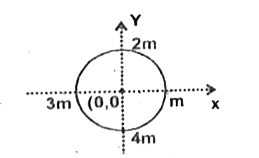Two particles of mass m each are rotating parallel to xz plane in circle of radius R as shown. They are connected by a mass less rod of length 2√2R as shown.

Consider the situation when the particles are at (R, R,0) and (-R, -R, 0). Neglect gravity and any kind of friction. Answer following questions
The angular velocity vector of the system of two particles and the total angular momentum of system about origin make an angle of
45∘
90∘
0∘
180∘
The correct Answer is:A
→ω along -ve y direction
→L=(Rˆi+Rahtj)×m(vˆk)+(−Rˆi−Rˆj)×mvˆk ltbr> =(−mvRˆj+mvRˆi)z=mvR×2[ˆi−ˆj]
⇒→ω&→L have angle of 45∘
Topper's Solved these Questions
- TEST PAPERSBOOK - BANSALCHAPTER - TEST PAPERSEXERCISE - PHYSICS PART (A)
32 Videos
- TEST PAPERSBOOK - BANSALCHAPTER - TEST PAPERSEXERCISE - PHYSICS PART (B)
3 Videos
- TEST PAPERSBOOK - BANSALCHAPTER - TEST PAPERSEXERCISE - PHYSICS PART- C
4 Videos
- SEMICONDUCTORSBOOK - BANSALCHAPTER - SEMICONDUCTORSEXERCISE - CBSE Question
32 Videos
Similar Questions
Two particles of equal mass m0 are moving round a circle of radius r due to their mutual gravitational interaction. Find the time period of each particle.
View SolutionTwo masses on 1kg each are rotating in a circle of radius R under their gravitational force. Find their angular speed in terms of G and R
View Solution
Knowledge Check
A particle of mass m is moving along a circle of radius r with a time period T. Its angular momentum is
A2πmrTB4πmrTC2πmr2TD4πmr2TA particle of mass m is rotating in a plane in circular path of radius r. Its angular momentum is L. The centripetal force acting on the particle is
AL2/mrBL2m/r2CL2/m2r2DL2/mr3Two particles of mass M and m are moving in a circle of radii R and r. if their time period are the same, what will be the ratio of their linear velocities?
AMR:mrBM:mCR:rD1:1
_S01_003_Q01.png)
Two particles of equal mass (m) each move in a circle of radius (r) under the action of their mutual gravitational attraction find the speed of each particle.
View SolutionFour particles of equal mass are moving round a circle of radius r due to their mutual gravitational attraction . Find the angular velocity of each particle .
View SolutionFour particles of masses m, 2m, 3m & 4m respectively are placed on the periphery of a circle of radius R as shown in the figure then CM of the system contains the particle is at

View SolutionIf a particle of mass m is moving in a horizontal circle of radius r with a centripetal force (−1/r2) , the total energy is
View SolutionTwo particles of equal mass m go around a circle of radius R under the action the of their mutual gravitational attraction . The speed v of each particle is
View Solution
